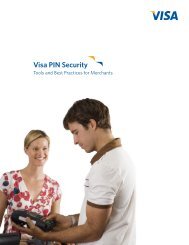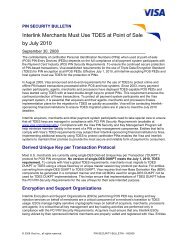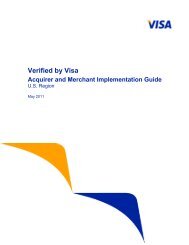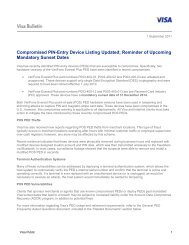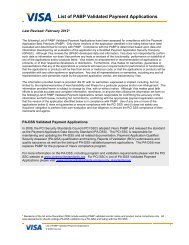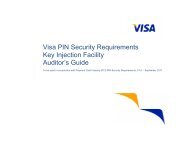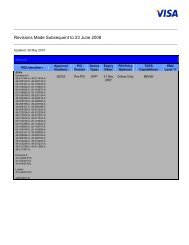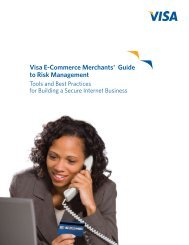Issuer PIN Security Guidelines - Visa
Issuer PIN Security Guidelines - Visa
Issuer PIN Security Guidelines - Visa
You also want an ePaper? Increase the reach of your titles
YUMPU automatically turns print PDFs into web optimized ePapers that Google loves.
Offline <strong>PIN</strong><br />
Generation<br />
<strong>Issuer</strong><br />
Assigned <strong>PIN</strong><br />
Cardholder<br />
Selected <strong>PIN</strong><br />
• The issuer should generate a reference <strong>PIN</strong> for an IC card if offline <strong>PIN</strong><br />
verification is supported as a CVM . The stored reference <strong>PIN</strong> within the IC is<br />
identical to the transaction <strong>PIN</strong> entered by the cardholder .<br />
• All <strong>PIN</strong> data (offline and online) should be protected from the point it leaves<br />
the system that generated the <strong>PIN</strong> data to the point where it is stored on the<br />
card in accordance with payment-system brand vendor requirements for card<br />
personalization .<br />
• <strong>Issuer</strong> assigned derived <strong>PIN</strong>s should:<br />
– be derived cryptographically from either the PAN and/or some other<br />
value associated with the cardholder<br />
– Not be statistically biased (based upon a recognized standard for<br />
measuring statistical bias) .<br />
– Not be stored by the issuer .<br />
• <strong>Issuer</strong> derived random <strong>PIN</strong>s should be created using a true or pseudo-random<br />
number generator (for example using a random number generator compliant<br />
with ISO/IEC 18031 and tested using NIST SP 800-22) . Generated <strong>PIN</strong> values<br />
should be unpredictable and uniformly distributed within a permitted set of<br />
values .<br />
• Banks should advise cardholders against using the <strong>PIN</strong> as a credential for<br />
remote banking or any other service and provide for an alternative input<br />
format for remote banking credentials, e .g . forbidding all-numeric passwords .<br />
(See also General <strong>PIN</strong> management guidelines section) .<br />
• If the cardholder selects the <strong>PIN</strong>:<br />
– the cardholder should be provided with appropriate guidance for <strong>PIN</strong><br />
selection and usage . (See General <strong>PIN</strong> management guidelines section)<br />
– the <strong>PIN</strong> value should be protected from the point of <strong>PIN</strong> entry and beyond<br />
(See sections: Cardholder <strong>PIN</strong> selection by internet and Cardholder <strong>PIN</strong><br />
selection by IVR)<br />
Cardholder Selected <strong>PIN</strong> by mail<br />
• If the cardholder selects the <strong>PIN</strong> by mail the <strong>PIN</strong> advice form should:<br />
– provide unambiguous instructions for completion of the form<br />
– use a cryptographically derived reference or control number (See<br />
section on control number) to link the selected <strong>PIN</strong> to the account<br />
– use a reference or control number that does not disclose the account<br />
number<br />
– Not contain any information which directly relates the <strong>PIN</strong> to the<br />
cardholder’s account, name, or address once completed by the<br />
cardholder .<br />
<strong>Issuer</strong> <strong>PIN</strong> <strong>Security</strong> <strong>Guidelines</strong> 2 1<br />
<strong>Visa</strong> Public © 2010 <strong>Visa</strong>. All Rights Reserved.



